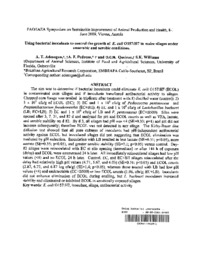Using bacterial inoculants to control the growth of E. coli O157:H7 in maize silages under anaerobic and aerobic conditions.
Using bacterial inoculants to control the growth of E. coli O157:H7 in maize silages under anaerobic and aerobic conditions.
Summary: The aim was to determine if bacterial inoculants could eliminate E. coli O157:H7 (ECOL) in contaminated corn silages and if inoculants transferred antibacterial activity to silages. Chopped corn forage was ensiled in triplicate after treatment with:1) distilled water (control); 2) 5 x 105 cfu/g of ECOL (EC); 3) EC and 1 x 106 cfu/g of Pediococcus pentosaceus and Propionibacterium freudenreichii (EC+BII); 4) EC and 1 x 106 cfu/g of Lactobacillus buchneri (LB; EC+LB); 5) EC and 1 x 106 cfu/g of LB and P. pentosaceus (EC+B500). Silos were opened after 3, 7, 31, and 82 d and analyzed for pH and ECOL counts as well as VFA, lactate, and aerobic stability on d 82. By d 3, all silages had pH was <4 (SE=0.33; p=1) and pH did not increase subsequently; therefore ECOL was not detected in any silage. The Kirby-Bauer disc diffusion test showed that all pure cultures of inoculants had pH-independent antibacterial activity against ECOL but inoculated silages did not, suggesting that ECOL elimination was mediated by pH reduction. Inoculation with LB resulted in less lactate (SE=0.31; p<0.05), more acetate (SE=0.35; p<0.05), and greater aerobic stability (SE=7.1; p<0.05) versus control. Day-82 silages were reinoculated with EC at silo opening (immediate) or after 144 h of exposure (delay) and ECOL were enumerated 24 h later. All immediately reinoculated silages had low pH values (<4) and no ECOL 24 h later. Control, EC, and EC+BII silages reinoculated after the delay had relatively high pH values (4.71, 5.67, and 6.03) (SE=0.74; p<0.05) and ECOL counts (2.87, 6.73, and 6.87 log cfu/g) (SE=1.4; p<0.05), whereas those treated with LB had low pH values (<4) and undetectable (EC+B500) or low ECOL counts (1.96, cfu/g; EC+LB). Inoculants did not enhance elimination of ECOL during ensiling, but L. buchneri inoculants increased stability and eliminated or inhibited ECOL in aerobically exposed silages.
Publication year: 2009
Types of publication: Abstract in annals or event proceedings
Observation
Some of Embrapa's publications are published as ePub files. To read them, use or download one of the following free software options to your computer or mobile device. Android: Google Play Books; IOS: iBooks; Windows and Linux: Calibre.
Access other publications
Access the Agricultural Research Database (BDPA) to consult Embrapa's full library collection and records.
Visit Embrapa Bookstore to purchase books and other publications sold by Embrapa.

